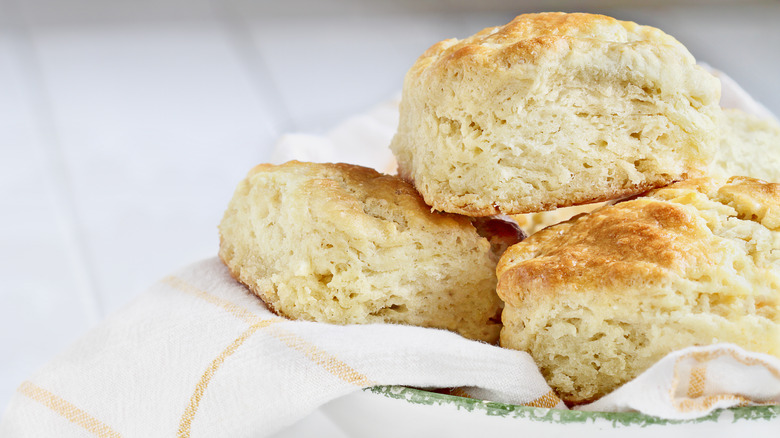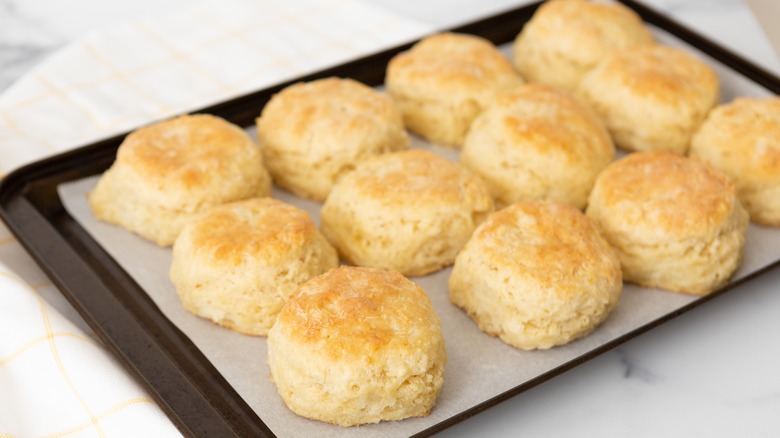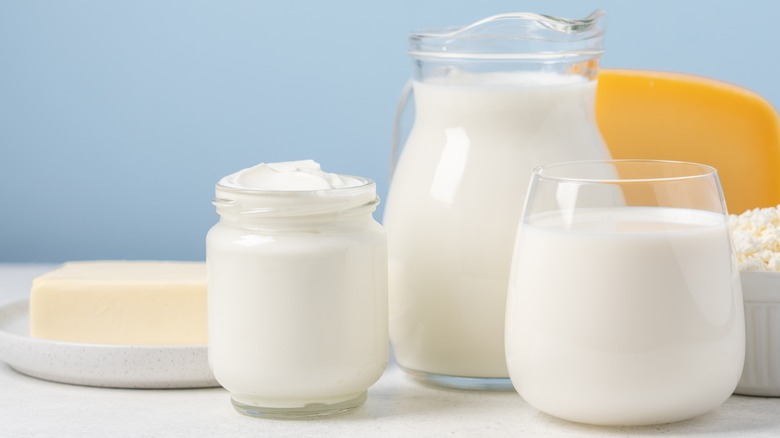White Lily Flour Is The Secret To Unbearably Fluffy Biscuits
All-purpose flour may sound all-encompassing, but the truth is that some flours are better suited than others for specific pastries. When it comes to baking the best biscuits, there's only one kind you should be reaching for: White Lily Flour.
White Lily was founded in Knoxville, Tennessee, in 1883 and has since earned a reputation as a Southern institution, even after relocating its headquarters to the Midwest in 2007. What sets White Lily apart from other flour producers is the type of wheat it mills. There are tens of thousands of wheat varieties, but they tend to be categorized into two general types: hard and soft. White Lily Flour is made from soft red winter wheat, which contains less protein than hard wheats and, therefore, produces less gluten during the baking process. While plenty of gluten is critical for baking crusty bread loaves and other pastries with chewy, sturdy doughs, minimal gluten development is ideal for the more delicate, tender crumb of biscuits. It's thanks to this aptly named "soft" wheat that White Lily Flour yields perfectly pillowy biscuits.
Tips and tricks for the best biscuits
A simple buttermilk biscuit recipe typically requires only about a half-dozen ingredients, but when you choose White Lily Self-Rising Flour, your ingredient list shortens even further to just three items: flour, butter, and buttermilk. This is important not just for convenience, but also because it helps avoid adding an excess of rising agents, such as baking powder, which could cause your biscuits to taste bitter and collapse into flat, hard pucks in the oven.
In addition to selecting the right flour, there are also steps you can take during the baking process to limit the amount of gluten formation in your biscuit dough. First, ensure you follow the recipe directions for mixing your ingredients. Combine the flour with butter before adding the buttermilk to prevent it from absorbing too much water. Then, mix the dough just until it comes together, and avoid over-kneading. These measures will help ensure that your baked biscuits turn out fluffy and light.
Optimizing other key ingredients in biscuits
Since biscuits are made with only a few ingredients, the quality of each is crucial for their overall taste and texture. Buttermilk is generally recommended for baking biscuits because it undergoes a fermentation process that makes it more acidic than regular milk, accounting for its slightly sour flavor and thick consistency. This acidity contributes to a higher rise in your dough, resulting in extra airy biscuits. If you don't have any on hand, you can transform milk into buttermilk by adding a squeeze of lemon juice or a splash of vinegar to the milk.
Biscuits always need some source of fat for richness, moisture, and structure, and while butter is the go-to option, there are plenty of alternatives, such as lard, shortening, and even coconut oil. (This last one can be paired with a dairy-free buttermilk alternative, such as coconut milk yogurt, for a vegan-friendly batch of biscuits.) Even if you stick with the classic choice, there are various types of butter to choose from, including compound butters, which are an easy way to incorporate additional flavors, such as garlic or cinnamon, into your biscuits.



